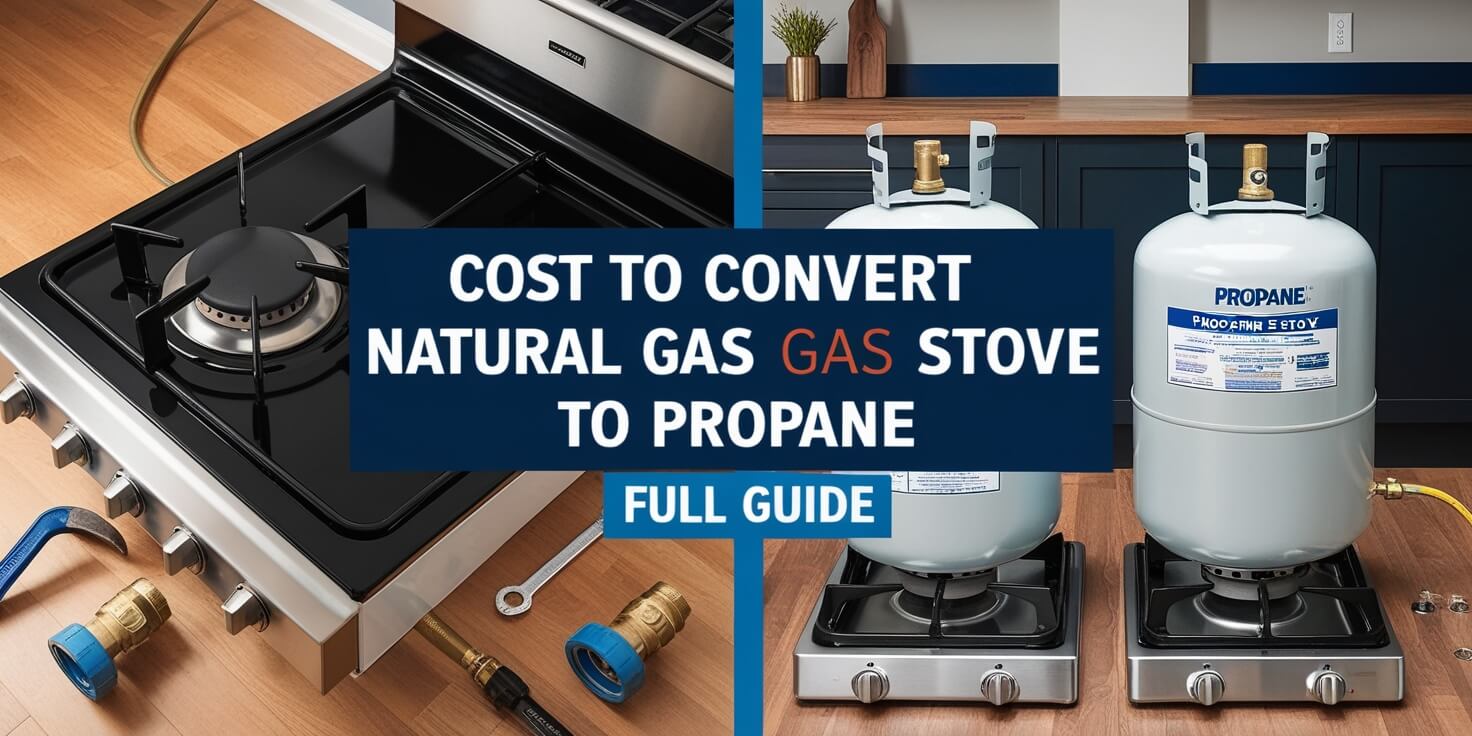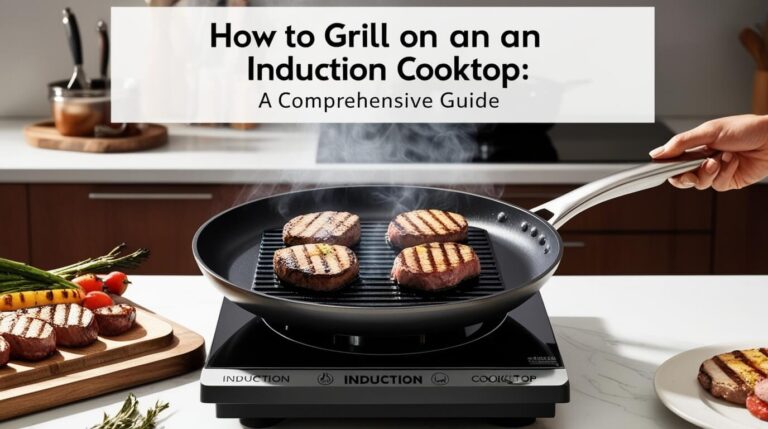
Are you thinking about switching your kitchen stove from natural gas to propane? You’re not alone. Many homeowners consider this change for various reasons, from moving to an area without natural gas lines to seeking more efficient cooking options. But before you make the switch, it’s crucial to understand the costs involved.
The cost to convert a natural gas stove to propane typically ranges from $80 to $300. This price can vary based on several factors, including your stove model, whether you choose DIY or professional installation, and any additional equipment needed.
In this guide, we’ll break down everything you need to know about converting your natural gas stove to propane. We’ll explore the costs, benefits, process, and important considerations to help you make an informed decision.
Why Convert from Natural Gas to Propane?
Before we dive into the costs, let’s look at why you might want to make this switch.
Benefits of Propane Stoves
Propane stoves offer several advantages over their natural gas counterparts:
- Portability: Propane tanks are portable, making them ideal for areas without natural gas lines.
- Higher heat output: Propane burns hotter than natural gas, allowing for more precise temperature control.
- Energy efficiency: Propane is a more energy-dense fuel, meaning you get more heat per unit of fuel.
- Environmental impact: Propane is considered a cleaner-burning fuel compared to natural gas.
Comparing Natural Gas and Propane for Cooking
Both natural gas and propane have their merits for cooking. Here’s a quick comparison:
- Heat output: Propane produces about 2,500 BTUs per cubic foot, while natural gas produces around 1,000 BTUs.
- Flame control: Both offer good flame control, but propane’s higher heat output can provide more precise temperature adjustments.
- Cost: Natural gas is generally cheaper, but propane prices can be more stable in some areas.
- Availability: Natural gas requires a connection to municipal gas lines, while propane can be stored in tanks.
Factors Affecting the Cost of Natural Gas to Propane Conversion
Several factors influence the overall cost of converting your stove:
Stove Type and Model
Different stove models require different conversion kits. Some newer models are designed for easy conversion, while older or more complex stoves might need more extensive modifications.
Conversion Kit Prices
Conversion kits typically cost between $20 and $100. The price varies based on your stove’s make and model. Some kits are universal, while others are brand-specific.
Labor Costs for Professional Installation
If you opt for professional installation, labor costs can range from $50 to $200. This price depends on your location and the complexity of the conversion.
Additional Equipment Needs
You might need extra equipment like a propane tank, regulator, or new gas line. These can add to your total cost.
Breaking Down the Costs: What to Expect
Let’s look at a detailed breakdown of potential costs:
Average Cost Range for Conversion
Here’s a typical cost breakdown:
- Conversion kit: $20 – $100
- Professional installation: $50 – $200
- Additional equipment: $0 – $200
Total range: $80 – $500
DIY vs. Professional Conversion: Cost Comparison
DIY conversion can save you money on labor costs. However, it’s crucial to weigh this against potential risks and the need for proper tools and knowledge.
DIY cost range: $20 – $300
Professional conversion cost range: $100 – $500
Hidden Costs to Consider
Don’t forget these potential additional expenses:
- Propane tank purchase or rental
- Regular propane refills
- Possible modifications to your kitchen setup
- Safety inspections
Step-by-Step Process of Converting a Natural Gas Stove to Propane
Understanding the conversion process can help you decide whether to DIY or hire a professional.
Assessing Your Stove’s Compatibility
First, check if your stove is convertible. Look for a rating plate that says “Natural Gas and LP” or “Convertible to LP.”
Purchasing the Right Conversion Kit
Buy a conversion kit specific to your stove model. These kits usually include:
- New gas orifices
- Regulator conversion parts
- Instructions
Tools Needed for the Conversion
You’ll typically need:
- Adjustable wrench
- Screwdrivers
- Pliers
- Leak detection solution
Safety Precautions During Conversion
Safety is paramount. Always:
- Turn off the gas supply
- Ensure proper ventilation
- Test for leaks after conversion
- Follow manufacturer instructions carefully
DIY Conversion: Is It Worth the Savings?
DIY conversion can save money, but it’s not for everyone.
Pros and Cons of DIY Stove Conversion
Pros:
- Cost savings on labor
- Learning experience
Cons:
- Risk of improper installation
- Potential safety hazards
- Time-consuming for inexperienced individuals
Skills Required for Self-Conversion
To safely convert your stove, you should:
- Be comfortable working with gas appliances
- Have basic plumbing knowledge
- Be able to follow technical instructions precisely
Potential Risks and Liabilities
Improper conversion can lead to:
- Gas leaks
- Fire hazards
- Carbon monoxide poisoning
- Voided warranties or insurance issues
Hiring a Professional: What to Look For
If you decide to hire a pro, here’s what to consider:
Qualifications to Check
Look for:
- Licensed and insured professionals
- Experience with gas stove conversions
- Positive customer reviews
Questions to Ask Before Hiring
- How many similar conversions have you done?
- Are you familiar with my stove model?
- What’s included in your service?
- Do you provide a warranty on your work?
Average Labor Costs for Professional Conversion
Professional conversion typically costs $50 to $200, depending on your location and the job’s complexity.
Long-Term Cost Implications of Converting to Propane
Consider these factors when evaluating long-term costs:
Propane vs. Natural Gas Prices: A Comparison
Propane is generally more expensive than natural gas. However, prices can vary greatly by region and season.
Efficiency and Energy Savings
Propane’s higher energy density might offset its higher cost. You may use less fuel to achieve the same cooking results.
Maintenance Costs for Propane Stoves
Propane stoves typically have similar maintenance needs to natural gas stoves. Regular cleaning and occasional professional check-ups are recommended.
Legal and Safety Considerations
Don’t overlook these important aspects:
Local Regulations for Gas Stove Conversions
Check your local building codes. Some areas require permits or professional installation for gas appliance conversions.
Insurance Implications of DIY Conversion
DIY conversion might affect your home insurance. Check with your provider before proceeding.
Safety Inspections and Certifications
After conversion, consider getting a safety inspection. This ensures everything is working correctly and safely.
Alternative Options to Consider
Before committing to conversion, explore these alternatives:
Buying a New Propane Stove vs. Converting
Sometimes, buying a new propane stove can be more cost-effective than converting an old one. Compare prices and features of new models.
Dual Fuel Stoves: A Versatile Option
Dual fuel stoves can use both natural gas and propane. They offer flexibility but are typically more expensive.
Environmental Impact of Natural Gas vs. Propane Stoves
Both fuels have environmental considerations:
Carbon Footprint Comparison
Propane generally has a lower carbon footprint than natural gas. It produces fewer greenhouse gases when burned.
Sustainability Considerations
Propane is a byproduct of natural gas processing and oil refining. Its production doesn’t require additional resource extraction.
Frequently Asked Questions About Natural Gas to Propane Conversion Costs
Let’s address some common queries:
- Q: Can all natural gas stoves be converted to propane? A: Not all stoves can be converted. Check your stove’s manual or rating plate to confirm.
- Q: How long does the conversion process take? A: A professional can typically complete the conversion in 1-2 hours.
- Q: Will converting to propane save me money in the long run? A: It depends on local fuel prices and your cooking habits. Calculate potential savings based on your area’s rates.
- Q: Do I need a special propane tank for my stove? A: Yes, you’ll need a propane tank. Size depends on your usage and local regulations.
- Q: How often will I need to refill my propane tank? A: This varies based on usage. A typical household might refill every 3-6 months.
Conclusion
Converting a natural gas stove to propane involves various costs and considerations. While the initial expense typically ranges from $80 to $300, factors like your stove model, installation method, and additional equipment needs can influence the final price.
Remember to weigh the long-term implications, including fuel costs, efficiency, and environmental impact. Whether you choose DIY or professional installation, prioritize safety and compliance with local regulations.
By understanding these factors, you can make an informed decision about whether converting your natural gas stove to propane is the right choice for your home and budget. Always consult with professionals if you’re unsure about any aspect of the conversion process.






